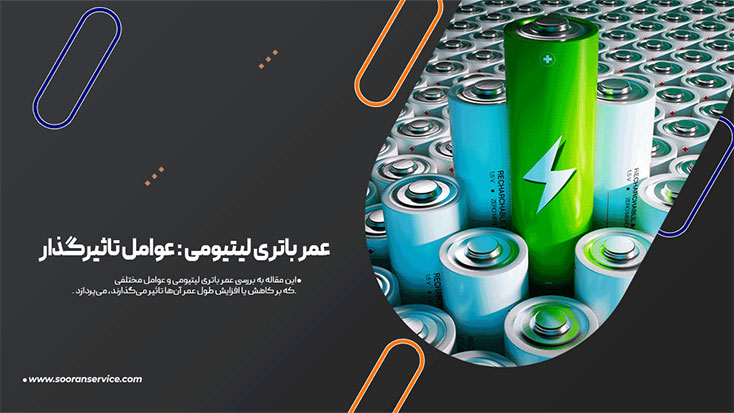The lifespan of a lithium battery depends on several factors such as the number of charge and discharge cycles, ambient temperature, and how the battery is used. Lithium batteries are among the most widely used energy sources in modern electronic devices.
Due to their high capacity, lightweight design, and longer lifespan compared to other types of batteries, they are commonly found in smartphones, laptops, electric vehicles, and other high-consumption electronic devices.
However, over time, the capacity of lithium batteries gradually decreases. This reduction in capacity typically occurs after extended use and a large number of charge cycles.
To extend the lifespan of these batteries, it is important to follow best practices — such as avoiding full discharges, preventing overcharging, using standard chargers, and maintaining an appropriate operating temperature.
In this article, we will explore the characteristics of lithium batteries and the key factors that affect their longevity. Stay with us to learn how to optimize their performance and ensure longer-lasting efficiency.
What Is a Lithium Battery?
A lithium battery is a type of rechargeable battery that uses advanced technology to store and deliver energy efficiently. These batteries use lithium — a very lightweight and highly reactive metal — as one of the key components in their chemical structure.
Due to their unique properties, lithium batteries are widely used in electronic devices and advanced technologies such as mobile phones, laptops, electric vehicles, and solar energy storage systems.
A typical lithium battery consists of three main components:
- Cathode, usually made of lithium metal oxides
- Anode, typically made of graphite
- Electrolyte, a substance that allows lithium ions to move between the anode and cathode
How Long Does a Lithium Battery Last?
The lifespan of a lithium battery depends on several factors, including the battery type, usage patterns, environmental conditions, and manufacturing quality. Generally, battery life is measured by the number of full charge and discharge cycles it can handle. A single charge cycle is defined as discharging the battery from 100% to 0% and then recharging it back to 100%.
Most high-quality lithium batteries are designed for 300 to 500 full charge cycles, although advanced models can reach up to 1,000 cycles or more. Typically, after 300–500 cycles, a battery’s capacity may drop to around 80% of its original capacity, and after 1,000 cycles or more, it may fall to 60% or lower.
Factors Affecting Lithium Battery Lifespan
Several factors influence a lithium battery’s lifespan and can gradually reduce its capacity and performance over time:
- Frequent Full Discharges: Regularly draining the battery to 0% can cause serious damage to its chemical structure. It’s best to keep the charge level between 20% and 80%.
- Overcharging: Keeping the battery plugged in long after reaching 100% can gradually degrade its capacity.
- High Temperature: Excessive heat can damage the electrolyte and internal components of the battery. Using devices in hot environments or direct sunlight shortens their lifespan.
- Material and Manufacturing Quality: High-quality lithium batteries from reputable manufacturers generally last longer.
- Using Standard Chargers: Non-standard chargers may deliver incorrect voltage or current, which can damage the battery and shorten its life.
- Self-Discharge: Lithium batteries naturally lose some charge even when not in use. Prolonged storage without recharging can harm the battery.
- Heavy Applications: Running high-performance applications that demand intensive processing power can drain the battery faster and increase its temperature.
- Continuous Usage: Using a device continuously without breaks — especially over long periods — puts extra stress on the battery.
- Number of Charge Cycles: Ultimately, a battery’s lifespan depends on how many full charge–discharge cycles it undergoes.

Best Practices for Lithium Battery Maintenance
To extend the lifespan and maintain the performance of lithium batteries, it’s essential to follow proper usage and maintenance guidelines. Below are some of the most important tips for keeping your lithium battery in optimal condition:
Use the Original Charger:
Always use the charger specifically designed for your device. Non-standard chargers may deliver incorrect voltage or current, which can damage the battery.
Avoid Cheap or Low-Quality Chargers:
Inexpensive chargers often lack protective mechanisms to prevent overcharging or overheating, which can shorten the battery’s lifespan.
Disable Unnecessary Background Apps:
Applications running in the background can drain the battery faster and gradually reduce its overall life.
Enable Battery Saver Mode:
When high performance is not needed, switch to Battery Saver Mode to reduce power consumption.
Reduce Screen Brightness:
High screen brightness is one of the main factors that increase lithium battery usage. Adjust the brightness to a moderate level whenever possible.
Avoid Using the Device While Charging:
Running demanding applications, such as games or high-definition video playback, during charging can cause the device to overheat and decrease the battery’s lifespan.
Monitor Battery Health:
Most modern devices provide an option to check battery health. Review these reports periodically, and if you notice a significant drop in capacity, consider replacing or servicing the battery.
Prevent Physical Damage:
Lithium batteries are sensitive to impact or physical stress. Avoid dropping or pressing the device, as such conditions can damage the internal structure of the battery.
Use Battery Optimization Software:
Various applications can help manage and optimize battery usage. Utilizing such tools can reduce power consumption and extend the overall life of the battery.
Conclusion
In conclusion, lithium batteries — with their high energy density, lightweight design, and reliable performance — represent one of the most significant innovations in modern technology. However, their lifespan is limited and highly dependent on proper usage and maintenance.
By following simple yet effective practices such as correct charging, avoiding extreme temperatures, using standard chargers, and managing energy consumption, you can significantly extend the useful life of your lithium batteries.
Although gradual capacity loss over time is inevitable, proper care allows you to get the most out of your investment in lithium-powered devices and maintain optimal performance for a longer period.
For more information or expert assistance, feel free to contact us.




No comments yet.